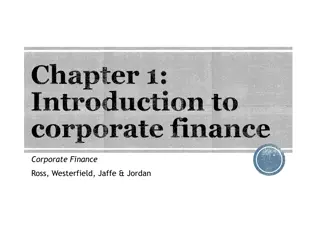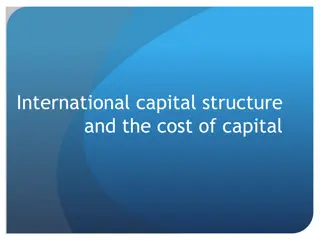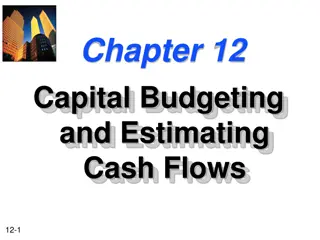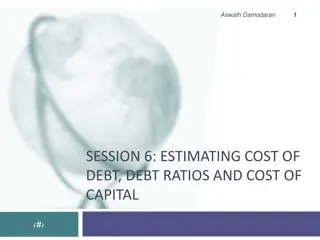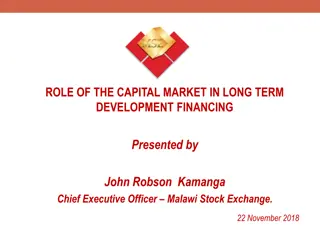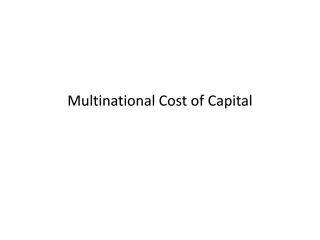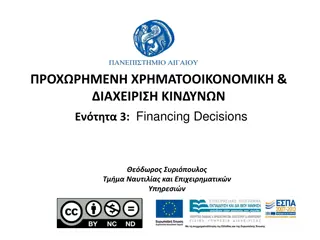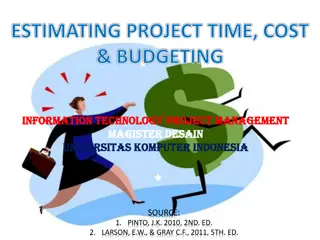Estimating the Cost of Capital in Corporate Finance
Explore the process of estimating the cost of capital essential for discounted cash flows models in corporate finance. Learn how to determine the cost of debt, equity capital, and the Weighted Average Cost of Capital (WACC) by combining different sources of financing. Gain insights into capital structure theories and the importance of understanding the return expected by investors for the capital they provide.
Download Presentation

Please find below an Image/Link to download the presentation.
The content on the website is provided AS IS for your information and personal use only. It may not be sold, licensed, or shared on other websites without obtaining consent from the author. Download presentation by click this link. If you encounter any issues during the download, it is possible that the publisher has removed the file from their server.
E N D
Presentation Transcript
& 5: Cost of Capital Estimation
University of the Aegean School of Business Studies Shipping, Trade & Transport Dpt. MA Shipping, Trade & Transport e-course Advanced Corporate Finance ADVFIN THEODORE SYRIOPOULOS Professor of Finance Department of Shipping, Trade & Transport School of Business Studies UNIVERSITY OF THE AEGEAN 2A, Korai street, 82100 Chios, Greece, Tel.: 22710 35 861, 6944 911 787 e-mail: tsiriop@aegean.gr http://www.stt.aegean.gr/SyriopoulosEn.asp
ESTIMATING THE COST OF CAPITAL
Background Cash is not free it comes at a price ! the price is the cost to the firm of using investors money cost of capital: return expected by investors for capital they supply 6
Background objectives: show how to estimate the cost of capital to be used in discounted cash flows models (valuation) investors do not normally invest directly in projects but in firms that undertake projects 7
Background assume there are only 2 types of securities straight bonds (loans) common shares 8
Background returns expected from firm s assets must be total of: [returnsexpected by bondholders ]+ [returns expected by shareholders] weightedby respective contribution to financing of these assets Weighted Average Cost of Capital(WACC) 9
Background understand: how to estimate the cost of debt how to estimate the cost of equity capital how to combine the cost of different sources of financing to obtain a firm s Weighted Average Cost of Capital 10
Capital structure & financial performance long-term firm financing : - equity (shares issuing ) - debt (borrowing: bank loan; bond issuing) - retained profits - combination 12
Equity vs. Debt equity vs. debt fundamental distinction: equity refers to firm s own funding by its shareholders shares correspond to ownership rights debt implies a core liability over specific time horizon 13
Capital Structure mix fundamental financial decision: which source of capital funding or mix should the firm prefer to finance its investment projects ? relative proportion of debt equity other securities outstanding... firm s capital structure 14
Capital Structure mix when firms fund raising from outside investors choose type of security to issue: equity - bond - combination ??? capital source & related funding costs affect firm s Weighted Average Cost of Capital (WACC) critical implications for : - ROE - corporate market value - corporate risk 15
Capital Structure mix implications a firm can attain growth & enhance corporate value only if:.. it undertakes investment projects than produce returns higher >>>> than cost of capital incorrect financing decisions may result to: - lower stock price - higher cost of capital - lost growth opportunities - increased probability of bankruptcy - potential wealth transfer 16
Capital Structure Irrelevance Principle seminal Modigliani-Miller theorem(MM, 1958) on capital structure irrelevance principle = cornerstone for firm s capital structure decisions in perfect markets basic theorem states: (assume absence of: taxes - bankruptcy costs - asymmetric information) in efficient markets that follow a certain price process (random walk) the value of a firm is unaffected by how that firm is financed it does NOT matter if firm's capital is raised by issuing stock or selling debt or what the firm s dividend policy is firm market value determined by its earning power & risk of underlying assets 17
Critics of Capital Structure Irrelevance critics of MM theorem : MM theory ignores risks of bankruptcy; as a firm's debt increases, this risk can be substantial bankruptcyrelated costs have two components: (1) the probability of financial distress; (2) the costs that would be incurred given that financial distress occurs 18
Trade-off Theory of Leverage trade-off theory of leverage : firms trade off benefits of debt financing (favourable corporate tax treatment) against higher interest rates & bankruptcy costs 19
Signaling theory in practice, managers have better information than outside investors, implying asymmetric (not symmetric) information effects financing decisions then indicate some signalling to market participants about firm prospects ( signaling theory ) 20
Signaling theory can emit negative signal (as seen by management): firm prospects are not bright announcement of a stock offering can depress firm s stock price (even if the firm s prospects are positive) firms with positiveprospects would try to avoid selling stock; seek to raise required new capital by other sources a debt offering is then taken as a positive signal the firm should maintain a reserve borrowing capacity to finance exceptional investment opportunities this in turn implies that firms should use - in normal times more equity & less debt (than is suggested by trade-off theory of leverage) 21
Pecking Order theory a firm can raise capital on a pecking order due to flotation costs & asymmetric information in a pecking order, a firm raises capital: first, internally by reinvesting net income & selling short-term marketable securities when that supply of funds has been exhausted the firm will issue debt & perhaps preferred stock only as a last resort will the firm issue common stock 22
Optimal Capital Structure optimal capital structure of firm: one that maximizes corporate market value (market price of firm s stock) 23
Estimating the cost of debt if a firm takes out a loan, firm s cost of debt interest rate charged by bank (if information is available) solve bond valuation formula for kD investors required rate of return Coupon PMT 1+ Coupon PMT 1+ Coupon PMT 1+ k Coupon PMT 1+ k Bond Price = + + + + t t+1 t+2 T ( ) ( ) ( ) ( ) t t + 1 +2 t T k k D D D D this rate is estimated cost of debt for the firm (issuer) It is bond s yield-to-maturity (y-t-m) 25
Estimating the cost of debt example: SMC publicly issued a bond 5-year ago original maturity = 10 years bond will be repaid 5 years from now current / remaining maturity = 5 years each bond trance = $1,000 annual coupon = 8% coupon payment = $80 bond current market price = $1,080 bond s expected rate of return (yield to maturity) = SMC cost of debt yield to maturity (ytm): measures what investor return on a bond will be, if bond is held to maturity (& all coupons reinvested at ytm rate); ytm = IRR on bond's cash flows 26
Estimating the cost of debt interpretation: an investor to buy SMC bond now & plan to keep it until maturity can expect to receive from SMC: $80 every year (coupon payment) for next 5-years remaining + $1,000 (principal amount) at end of 5th year in bond markets: $1,080 = [$80 / (1+ kD)1] + [$80 / (1+ kD)2] + [$80 / (1+ kD)3] + [$80 / (1+ kD)4] + [$1,080 / (1+ kD)5] kD= 6.10% kD = bondholder's expected return =firm s estimated cost of debt Interpretation - Why ? this reflects interest rate cost SMC has to pay if it decided today to issue new bonds to investors 27
Corporate Bond Valuation INT INT INT M = + + + + V ( ) INT ( ) ( ) ( ) d 1 2 N N + + + + 1 k 1 k 1 k 1 k d d d d M N = + ( )N ( ) = t + + 1 k 1 k d d t 1 28
Corporate Bond Valuation & Risk determined by its risk Bond yield major sources of bond risk to a bondholder market risk credit (default) risk credit rating: - investment grade bonds - speculative (junk) grade bonds yield investors require depends on bond s rating & interest rates at which government is borrowing for same maturity 29
Estimating the cost of debt if firm has nobonds outstanding , its cost of debt can be estimated by . add a credit risk spread to yield on government bonds of same maturity Cost of debt = market yield on government bond + estimated credit risk spread 30
Estimating the cost of debt since interest expenses are tax deductible , the AFTER-TAX cost of debt is relevant AFTER-TAX cost of debt = pre-tax cost of debt (1 marginal corporate tax rate) kDafter-tax = kDpre-tax x (1 TR) 31
Does Equity bear any cost ?... Debt firm must pay at a set rate of interest BUT Equity : firm does not have a concrete price to pay ! this does NOT mean that there is no cost of equity ! equity shareholders (owners) expect to obtain certain return on their investment in the firm 33
Does Equity bear any cost ?... From firm s perspective equity holders' required Rate of Return : cost for firm cost of equity if firm does not deliver this expected return shareholders will simply sell their shares (causing stock price to drop) or move their funds to alternative investment choices (opportunity cost) 34
Does Equity bear any cost ?... Cost of equity = what it costs the firm to maintain a share price that is satisfactory (at least in theory) to investors 35
Estimating the cost of equity: how reliable is the DDM ? alternative valuation approach is required: Capital Asset Pricing Model (CAPM) CAPM models investors (shareholders ) returns that are compensated for addition market risk undertaken the greater the risk the higher the expected return 36
Diversification reduces RISK risk of an asset (stock) can be broken-down into 2 components: unsystematicordiversifiable risk systematic ornon-diversifiable risk 37
Diversification reduces RISK thus: only risk that matters in determining the required returnon a financial asset is the asset s systematic risk required rate of return on a financial asset depends only on its systematic risk 38
Systematic vs. Unsystematic Risk Portfolio RISK TOTAL RISK = Systematic (market) Risk + Diversifiable (specific) Risk Diversifiable (specific) Risk Systemic (market ) Risk Number of assets (securities / projects) 39
Measuring Systematic Risk with the BETA coefficient a firm s systematic risk measured relative to market portfolio market portfolio = portfolio containing all of assets in the world / market of interest systematic risk of a stock - estimated by sensitivity of returns to changes in representative stock market index (e.g. S&P500 index) this is stock s beta coefficient 40
Beta coefficients stocks vs. market: US sample s > 1 aggressive stock behaviour vs. market portfolio s < 1 defensive stock behaviour vs. market portfolio s = 1 neutral stock behaviour vs. market portfolio ( mp = 1) Texas Instrument 1.60 AT&T 1.00 Black & Decker Corp. 1.50 Bayer AG 1.00 Maytag Corporation 1.50 0.90 McDonald s Navistar International 1.45 Dow Chemical 0.90 Intel Corporation 1.35 Shell Transport & Trading 0.90 World Com, Inc. 1.35 Smithkline Beecham 0.80 US Airways 1.35 Boston Beer 0.80 United Air Lines 1.20 Walgreen 0.80 IBM 1.20 TotalFinaElf 0.80 Hewlett Packard Company 1.20 Coca-Cola Co. 0.80 LVMH Moet Hennessy LV 1.20 New York Times, Co. 0.80 U.S. Home & Gardens, Inc. 1.20 Merck & Co., Inc. 0.70 Bank of America Corp. 1.15 Chevron Corporation 0.70 American Express Corp. 1.15 Diageo PLC 0.70 General Motors 1.10 American Water Works Co. 0.40 Air Gas 1.05 Consolidated Edison Co. 0.40 41
Capital Asset Pricing Model (CAPM) Treasury Bills safest investment available used as proxy for risk-free rate alternative to Treasury Bills: Government Bonds Market Risk Premium expected return of market portfolio minus risk-free rate 42
Capital Asset Pricing Model (CAPM) since betameasures a security s risk relative to market portfolio a security s risk premium = (project; portfolio; asset etc.) = (market risk premium) (security s beta) 43
Capital Asset Pricing Model (CAPM) CAPM states* : expected return on any security (Ri) = risk-free rate (RF) + (market risk premium x security s beta) ((RM-RF) x i) ( ) R = R + R - R i F M F i 44
CAPM model (diagram) 12.5 CAPM depicts asset's expected return vs. risk (beta) as a linear relationship represented by the security market line 45
CAPM to estimate firms cost of equity assume: government bond yield = SMC s beta = market risk premium = market portfolio return = 5.8% 1.06 6.2% ??? KE, SMC = 5.8% + (6.2%) x 1.06 = 12.37% 46
Estimation of cost of equity with CAPM London Stock Exchange Beta Estimate Cost of Equity with the CAPM Company Industry Coefficient British Airways Airline 1.30 5.1% x (6.2% x 1.3) = 13.2% Smithkline Beecham Pharmaceuticals 1.15 5.1% x (6.2% x 1.15) = 12.2% British Telecom Telecommunications 0.94 5.1% x (6.2% x 0.94) = 11.0% Inchcape Distribution 0.60 5.1% x (6.2% x 0.60) = 8.8% Marks & Spencer Retailing 0.44 5.1% x (6.2% x 0.44) = 7.8% Source: Datastream Government Bond Rate = 5.1% Market Risk Premium = 6.2% (November 2000) 47
Estimating a firms Cost of Capital What is the firm s cost of capital? minimum rate of returnthe firm (project) must generate in order to meet the return expectations of its suppliers of capital (shareholders debtdholders) 49
Estimating a firms Cost of Capital assuming that the firm is financed by debt + equity a firm s cost of capital is: Weighted Average Cost of Capital (WACC) = weighted average of (cost of debt + cost of equity) weights = relative shares (proportions) of debt + equity used in financing the firm s assets 50







